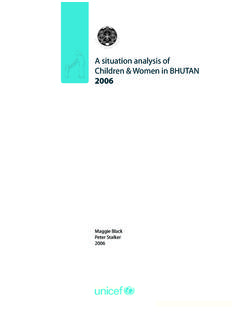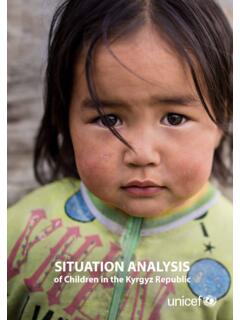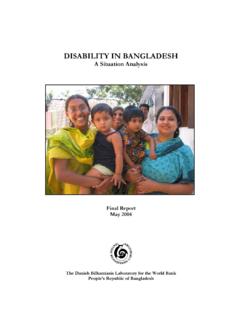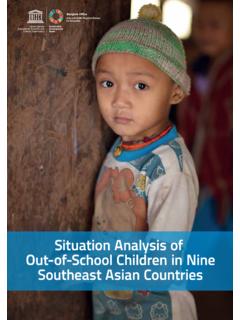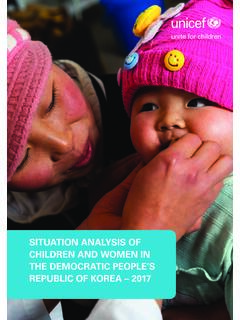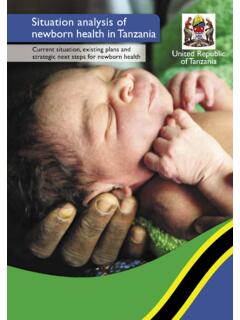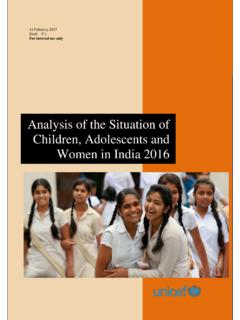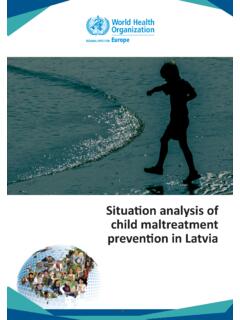Transcription of Situation Analysis of Children (SitAN) in Timor- Leste
1 1 Situation Analysis of Children (SitAN) in Timor- Leste Timor- Leste has changed dramatically. Since its independence of merely a decade ago, it has moved from a post-conflict country to a lower middle income developing country. As the country experienced socio-economic and security-related progress in recent years, the Situation of Children in Timor- Leste has also gradually improved. Nonetheless, there are several challenges still affecting Children in Timor- Leste .
2 A comprehensive Situation Analysis on Children is imperative to ensure evidence-based actions that address the remaining challenges within the changing context of the country. This Situation Analysis of Children 2014 (SitAn) provides an overview of Children s rights to health and nutrition, water, sanitation and hygiene, education, protection, and participation, with a special focus on disadvantaged Children and their families. The Analysis identifies key progress and persisting child deprivations, and explores the immediate and underlying causes of issues relating to supply, demand and quality of services which affect the equitable achievement of Children s rights in Timor- Leste .
3 The basic enabling environment for the improvement of Children s lives is also discussed. The SitAn aims to increase awareness and understanding of child development issues in the country and supports the implementation of the Fifth Constitutional Government s Programme (2012-2017) and the National Strategic Development Plan (2011-2030). Key achievements in child development in Timor- Leste Timor- Leste has achieved a remarkable 70 per cent reduction in under-five mortality rate (U5MR).
4 It is one of seven high mortality countries (Bangladesh, Ethiopia, Liberia, Malawi, Nepal, Timor- Leste and the United Republic of Tanzania) that have already achieved the Millennium Development Goal (MDG) on the reduction of under-five mortality rate (U5MR) by at least two-thirds since 19901. National household-based surveys found that the U5MR declined from 125 deaths per 1,000 live births in 20022 to 64 in 2009,3 surpassing the national MDG target of 96. Similarly, the infant mortality rate (IMR) - the probability of Children dying before their first birthday, declined from 88 per 1,000 live births in 2002 to 45 in 2009, way below the target of 53.
5 Although Timor- Leste is still among the countries with higher levels of under nutrition among Children under five years of age, progress has been made to improve the nutritional status of the population. Comparison between the 2009-2010 TLDHS data and the preliminary data from the 2013 Timor- Leste Food and Nutrition Survey shows that for Children under five years of age, prevalence of stunting declined from per cent to per cent; wasting decreased from per cent to per cent; and underweight dropped from per cent to per cent.
6 1 UNICEF (2013) Committing to Child Survival, a Promise Renewed, Progress Report 2013, New York: UNICEF. 2 2002 Multi-Indicators Cluster Survey (MICS) 3 2009-2010 Demographic and Health Survey (TLDHS) 2 Timor- Leste is on track to achieve the MDG target on improved drinking water. According to the 2010 Census, 66 per cent of the households had access to clean drinking water in 2010. The global Joint Monitoring Programme (JMP) for water and sanitation estimated that by 2011, 69 per cent of population in Timor- Leste had accessed safe drinking water, a 15 per cent increase since 2000.
7 Significant progress has been made in access to basic education with the achievement of a primary (grade 1-6) net enrolment rate (NER) of 94 per cent with gender equality in 20104 as compared to only 64 per cent in This is remarkable as the entire education system has been rebuilt from its foundations. The establishment of a National Commission for the Rights of the Child with a clear mandate to promote and monitor Children s rights is a remarkable step forward in advancing Children s rights in Timor- Leste .
8 Major issues, challenges and disparities Timor- Leste remains one of the countries with the highest prevalence of stunting among Children who are under five years of age. Further, about per cent of women in Timor- Leste have a body mass index (BMI) of less than , indicating under-nourishment, 15 per cent have short stature, and per cent are anaemic, which perpetuate the cycle of Child mortality is still high in Timor- Leste . Each year, around 1 in 16 Children dies before his/her fifth birthday (64 deaths per 1,000 live births).
9 7 Only two districts (Dili and Baucau) have an U5MR that is lower than the national average. Neonatal Mortality (child death within 28 days after birth) is high at 22 deaths for every 1,000 live births and has remained un-changed since Neonatal-related conditions, pneumonia, diarrhoea and malaria are major immediate causes of child deaths. Moreover, with a maternal mortality ratio (MMR) of 557 deaths per 100,000 live births,9 Timor- Leste is off track on the MDG target on maternal mortality10.
10 About 42 per cent of all deaths among women aged 15-49 years were due to risks associated with pregnancy and child birth. Timor- Leste is off-track to meet the MDG target on sanitation. The 2010 Census shows that only 39 per cent of households had access to improved sanitation facilities, an increase of only 2 percentage points since 2000. About 8 per cent of urban households and 37 per cent of rural households still practice open defecation. 4 2010 Education Statistical Yearbook 5 EMIS 2010 6 TLDHS 2009-2010 7 Ibid.
